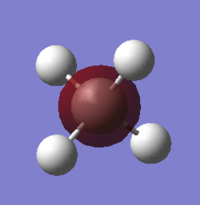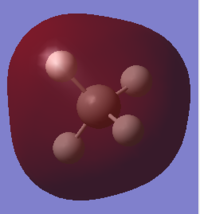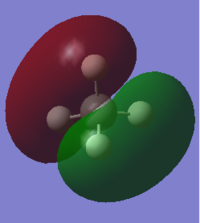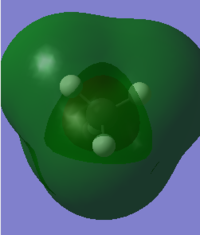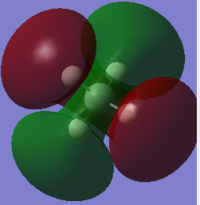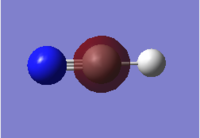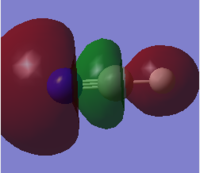Rep:Mod:YW21318
NH3
Key information
| Name of the molecule | NH3 |
|---|---|
| Calculation method | RB3LYP |
| Basis set | 6-31G(d,p) |
| Final energy E in atomic units (a.u.) | -56.55776873 |
| RMS gradient (a.u.) | 0.00000485 |
| Point group | C3v |
| Optimised N-H bond distance | 1.02 ± 0.01Å |
| Optimised H-N-H bond angle | 106 ± 1° |
Item table
Item Value Threshold Converged? Maximum Force 0.000004 0.000450 YES RMS Force 0.000004 0.000300 YES Maximum Displacement 0.000072 0.001800 YES RMS Displacement 0.000035 0.001200 YES
NH3 |
The optimisation file is linked to here
Vibrations

| Wavenumber /cm-1 | symmetry | intensity (arbitrary units) | image |
|---|---|---|---|
| 1090 | A1 | 145 | 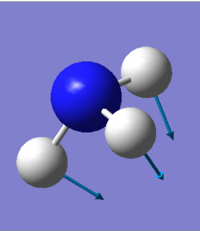 |
| 1694 | E | 14 |  |
| 1694 | E | 14 | 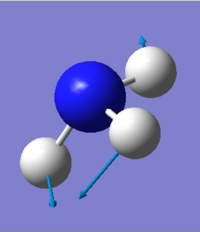 |
| 3461 | A1 | 1 | 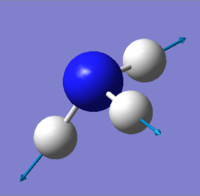 |
| 3590 | E | 0 |  |
| 3590 | E | 0 | 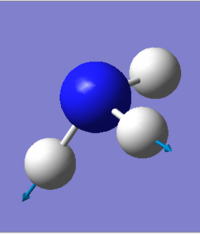 |
Questions relate to vibrations by their wavenumber
How many modes do you expect from the 3N-6 rule?
6 modes
Which modes are degenerate (ie have the same energy)?
Two modes have 1694cm-1 and the other two have 3590cm-1
Which modes are "bending" vibrations and which are "bond stretch" vibrations?
Bending vibrations: 1090 and 1694 cm-1
Bond stretch: 3461 and 3590 cm-1
Which mode is highly symmetric?
3461cm-1
One mode is known as the "umbrella" mode, which one is this?
1090cm-1
How many bands would you expect to see in an experimental spectrum of gaseous ammonia?
Two bands
Charge analysis
| N-atom | -1.125 |
|---|---|
| H-atom | 0.375 |
Because N is more eletronegative than H, so N is likely to have a negative charge and H is likely to have a positive charge.
N2
Key information
| Name of the molecule | N2 |
|---|---|
| Calculation method | RB3LYP |
| Basis set | 6-31G(d,p) |
| Final energy E in atomic units (a.u.) | -109.52412868 |
| RMS gradient (a.u.) | 0.00000060 |
| Point group | D∞h |
| Optimised N-N bond distance | 1.11 ± 0.01Å |
N2 is a diatomic molecule, so no bond angle.
Item table
Item Value Threshold Converged? Maximum Force 0.000001 0.000450 YES RMS Force 0.000001 0.000300 YES Maximum Displacement 0.000000 0.001800 YES RMS Displacement 0.000000 0.001200 YES
N2 |
The optimisation file is linked to here
Vibrations

| Wavenumber /cm-1 | symmetry | intensity (arbitrary units) | image |
|---|---|---|---|
| 2457 | SGG | 0 |  |
Charge analysis
| N-atom | 0.000 |
|---|---|
| N-atom | 0.000 |
N2 dosen't have dipole moment, so IR intensity is 0. It is a neutral molecule, so the charge on atoms are 0.
H2
Key information
| Name of the molecule | H2 |
|---|---|
| Calculation method | RB3LYP |
| Basis set | 6-31G(d,p) |
| Final energy E in atomic units (a.u.) | -1.17853936 |
| RMS gradient (a.u.) | 0.00000017 |
| Point group | D∞h |
| Optimised H-H bond distance | 0.74 ± 0.01Å |
H2 is a diatomic molecule, so no bond angle.
Item table
Item Value Threshold Converged? Maximum Force 0.000000 0.000450 YES RMS Force 0.000000 0.000300 YES Maximum Displacement 0.000000 0.001800 YES RMS Displacement 0.000001 0.001200 YES
H2 |
The optimisation file is linked to here
Vibrations
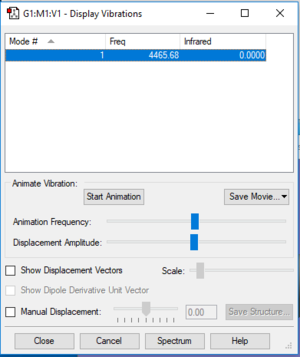
| Wavenumber /cm-1 | symmetry | intensity (arbitrary units) | image |
|---|---|---|---|
| 4465 | SGG | 0 | 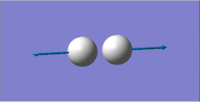 |
Charge analysis
| H-atom | 0.000 |
|---|---|
| H-atom | 0.000 |
H2 dosen't have dipole moment, so the IR intensity is 0. It is a neutral molecule, so the charge on atoms are 0.
Mono-metallic complex
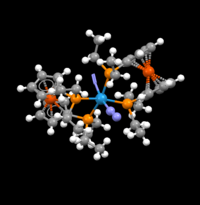
Identifier of this mono-metalic complex: AGISEP (CCDC 704102)
The basic information of this mono-metalic complex is shown on this page:
[[1]]
This mono-metallic complex contains two N-N bonds, which are 1.136(3) Å and 1.139(3) Å. Both of them are slightly longer than the optimised N2 bond length (1.11 ± 0.01Å). That is due to some electrons on N in the mono-metallic complex are delocalised to the nearby bonds, and results in a longer bond length. N-N is likely to have a resonance form and obtains some double bond characters.
Futhermore, the optimised bond length is measured from a single N2 molecule in gas state, which means there is no external influences on the bond. However, the N-N bond length in mono-metallic compelx is measured in solid state.
Haber-Bosch process
N2 + 3H2 -> 2NH3
Energy for this process (in a.u.):
E(NH3)= -56.55776873
2*E(NH3)= -113.1155375
E(N2)= -109.52412868
E(H2)= -1.17853936
3*E(H2)= -3.53561808
ΔE=2*E(NH3)-[E(N2)+3*E(H2)]= -113.1155375 - [(-109.52412868) + (-3.53561808)] = -0.05579074 = -146.5 kJ/mol
This reaction is a exothermic reaction, so ammonia product is more stable.
CH4
Key information
| Name of the molecule | CH4 |
|---|---|
| Calculation method | RB3LYP |
| Basis set | 6-31G(d,p) |
| Final energy E in atomic units (a.u.) | -40.52401404 |
| RMS gradient (a.u.) | 0.00003263 |
| Point group | Td |
| Optimised C-H bond distance | 1.09 ± 0.01Å |
| Optimised H-C-H bond angle | 109 ± 1° |
Item table
Item Value Threshold Converged? Maximum Force 0.000063 0.000450 YES RMS Force 0.000034 0.000300 YES Maximum Displacement 0.000179 0.001800 YES RMS Displacement 0.000095 0.001200 YES
CH4 |
The optimisation file is linked to here
Vibrations

| Wavenumber /cm-1 | symmetry | intensity (arbitrary units) | image |
|---|---|---|---|
| 1356 | T2 | 14 | 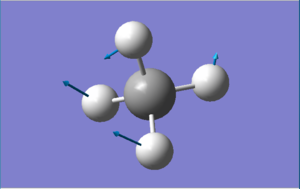 |
| 1356 | T2 | 14 | 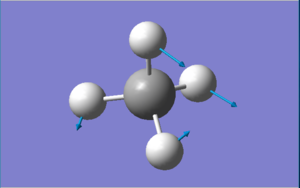 |
| 1356 | T2 | 14 |  |
| 1578 | E | 0 | 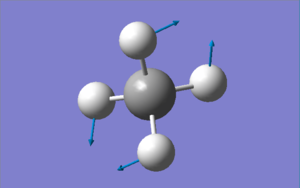 |
| 1578 | E | 0 | 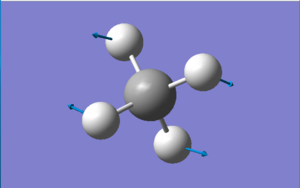 |
| 3046 | A1 | 0 | 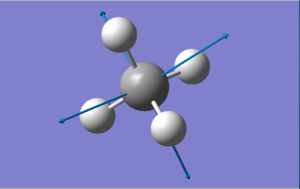 |
| 3162 | T2 | 25 | 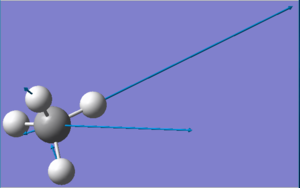 |
| 3162 | T2 | 25 | 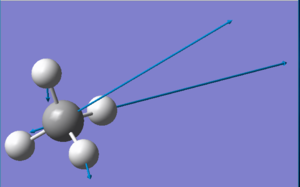 |
| 3162 | T2 | 25 | 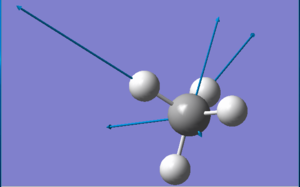 |
Charge analysis
| C-atom | -0.930 |
|---|---|
| H-atom | 0.233 |
Because C is more eletronegative than H, so carbon is likely to behave negatively and H is likely to have a positive charge instead.
Molecular orbital
Independence (HCN)
Key information
| Name of the molecule | HCN |
|---|---|
| Calculation method | RB3LYP |
| Basis set | 6-31G(d,p) |
| Final energy E in atomic units (a.u.) | -93.42458132 |
| RMS gradient (a.u.) | 0.00017006 |
| Point group | CV |
| Optimised C-H bond distance | 1.07 ± 0.01Å |
| Optimised C-N bond distance | 1.16 ± 0.01Å |
| Optimised H-C-N bond angle | 180° |
Item table
Item Value Threshold Converged? Maximum Force 0.000370 0.000450 YES RMS Force 0.000255 0.000300 YES Maximum Displacement 0.000676 0.001800 YES RMS Displacement 0.000427 0.001200 YES
HCN |
The optimisation file is linked to here
Vibrations
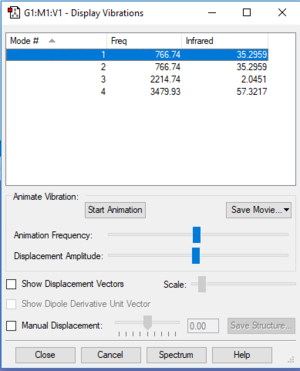
| Wavenumber /cm-1 | symmetry | intensity (arbitrary units) | image |
|---|---|---|---|
| 766 | PI | 35 |  |
| 766 | PI | 35 | 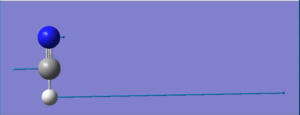 |
| 2214 | SG | 2 |  |
| 3479 | SG | 57 | 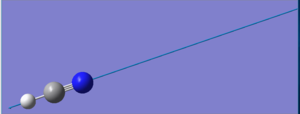 |
Charge analysis
| C-atom | 0.073 |
|---|---|
| H-atom | 0.234 |
| N-atom | -0.308 |
Because N is the most eletronegative atom among the three, so nitrogen is likely to behave negatively. Carbon's electronegativity is slightly higher than hydrogen, so carbon has a greater positive atom charge than hydrogen.
Molecular orbital
Marking
Note: All grades and comments are provisional and subject to change until your grades are officially returned via blackboard. Please do not contact anyone about anything to do with the marking of this lab until you have received your grade from blackboard.
Wiki structure and presentation 1/1
Is your wiki page clear and easy to follow, with consistent formatting?
YES
Do you effectively use tables, figures and subheadings to communicate your work?
YES
NH3 1/1
Have you completed the calculation and given a link to the file?
YES
Have you included summary and item tables in your wiki?
YES
Have you included a 3d jmol file or an image of the finished structure?
YES
Have you included the bond lengths and angles asked for?
YES
Have you included the “display vibrations” table?
YES
Have you added a table to your wiki listing the wavenumber and intensity of each vibration?
YES
Did you do the optional extra of adding images of the vibrations?
YES
Have you included answers to the questions about vibrations and charges in the lab script?
YES
N2 and H2 0.5/0.5
Have you completed the calculations and included all relevant information? (summary, item table, structural information, jmol image, vibrations and charges)
YES
Crystal structure comparison 0.5/0.5
Have you included a link to a structure from the CCDC that includes a coordinated N2 or H2 molecule?
YES
Have you compared your optimised bond distance to the crystal structure bond distance?
YES
Haber-Bosch reaction energy calculation 1/1
Have you correctly calculated the energies asked for? ΔE=2*E(NH3)-[E(N2)+3*E(H2)]
YES
Have you reported your answers to the correct number of decimal places?
YES
Do your energies have the correct +/- sign?
YES
Have you answered the question, Identify which is more stable the gaseous reactants or the ammonia product?
YES
Your choice of small molecule 4/5
Have you completed the calculation and included all relevant information?
YES
Have you added information about MOs and charges on atoms?
YES
You could have analysed the calculated vibrations. You could have explained the relative energies of the MOs.
Independence 1/1
If you have finished everything else and have spare time in the lab you could:
Check one of your results against the literature, or
Do an extra calculation on another small molecule, or
YES - you could have analysed the calculated vibrational modes and commented on the MOs in more detail.
Do some deeper analysis on your results so far

